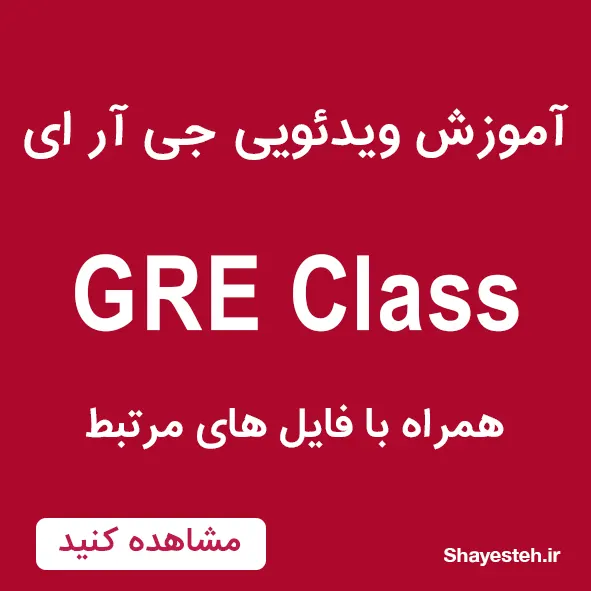در صورتی که اشکالی در ترجمه می بینید می توانید از طریق شماره زیر در واتساپ نظرات خود را برای ما بفرستید
09331464034
Topic:
Governments should offer college and university education free of charge to all students.
Write a response in which you discuss the extent to which you agree or disagree with the recommendation and explain your reasoning for the position you take. In developing and supporting your position, describe specific circumstances in which adopting the recommendation would or would not be advantageous and explain how these examples shape your position.
دولت ها باید تحصیلات پیش دانشگاهی و دانشگاهی را به طور رایگان به همه دانشجویان ارائه دهند.
پاسخی بنویسید که در آن درمورد موافقت یا مخالفت با این جمله بحث کنید و استدلال خود را درباره موضع گیری خود توضیح دهید. در توسعه و حمایت از موضع خود، باید شرایط خاصی را توضیح دهید که در آن، پذیرفتن این توصیه ممکن است مفید باشد یا نباشد و توضیح دهید که این مثال ها چگونه موضع شما را شکل می دهند.
موافق
- تحصیلات پیش دانشگاهی و دانشگاهی حق تمام افراد جامعه است و هیچ فردی نباید به علت نداشتن هزینه تحصیل از آن محروم بماند. بنابراین، دولت موظف است که امکان تحصیلات رایگان را برای همه دانشجویان فراهم کند.
- رایگان بودن تحصیلات دانشگاهی موجب می شود که دانشجویان تمام تمرکز خود را فقط روی درس بگذارند و دغدغه ای برای تهیه کردن شهریه نداشته باشند. به این ترتیب، بازدهی آنها بالاتر می رود.
- اگر تحصیلات رایگان نباشد، بسیاری از دانشجویان مجبورند بخشی از زمان خود را سر کار بروند تا شهریه دانشگاه را تهیه کنند و به جای اینکه وقت خود را صرف تحصیل کنند، مجبورند کار کنند. اما اگر تحصیلات رایگان باشد آنها تمام وقت خود را برای درس خواندن میگذارند و موفق تر خواهند بود.
- اگر دولت و مسئولین دانشگاه بتوانند رابطه ای بین دانشجویان و صنعت ایجاد کنند به نحوی که دانشجویان با کار پاره وقت برای دانشگاه بتوانند درآمدزایی داشته باشند، رایگان بودن تحصیلات پیش دانشگاهی و دانشگاهی راه حل بسیار مناسبی است.
مخالف
- اگر قرار باشد دولت، تحصیلات پیش دانشگاهی و دانشگاهی رایگان را برای همه افراد جامعه و دانشجویان فراهم کند هزینه بسیار بالایی را متحمل می شود و ممکن است برای اینکه بتواند از پس هزینه ها بربیاید، کیفیت مکان های آموزشی و یا نحوه تدریس را پایین بیاورد.
- دولت ها معمولاً نمیتوانند بودجه کافی برای تحصیل رایگان در دانشگاه ها فراهم کند. بنابراین، در طولانی مدت دانشگاهها با کمبود بودجه مواجه شده و نمی توانند بسیاری از تجهیزات مورد نیاز برای تحصیلات دانشگاهی را تامین کنند. مثلاً ممکن است در آزمایشگاه ها امکانات کافی وجود نداشته باشد و یا حتی دانشجویان، به کامپیوتر برای تقویت مهارت هایشان دسترسی نداشته باشد.
- اساتید هر دانشگاه باید از بین بهترین و نخبه ترین افراد جامعه انتخاب شوند تا بتوانند دانشجویان را به خوبی پرورش دهند اما در صورتی که تحصیلات برای همه رایگان باشد، دولت از عهده پرداخت حقوق اساتید برجسته بر نمی آید و در نتیجه مجبور میشود اساتیدی که تجربه کمتری دارند را برای تدریس استخدام کند و به این ترتیب کیفیت آموزش پایین میآید.
- اگر تحصیلات رایگان شود دانشگاه و دولت مجبورند به راهحلهایی فکر کنند که برای دانشگاه درآمدزا باشد. به این ترتیب مسئولین دانشگاه به جای اینکه تمرکز خود را روی بهبود روشهای تدریس و تجهیز دانشگاه برای فراهم آوردن امکانات بهتر و تربیت و پرورش دانشجویان بگذارند، مجبورند مدام وقت خود را صرف پیدا کردن منابعی برای تامین مالی دانشگاه کنند.
Strategies
A good starting point is to break down the statement and identify the assumptions it makes. Look for ambiguous phrasing and consider all possible exceptions – they represent weak points that you can defend or attack depending on your chosen position.
Statement breakdown:
a) Governments – state funded education
b) College and university – does it include masters, PhDs?
c) Free of charge – what expenses are paid (tuition, board etc.)? How about following multiple studies simultaneously? What about existing scholarships and welfare packages?
d) All students – including exchange students?
All statements are based on a set of assumptions about the world and the way it works – many of these social norms are implicit due to subconscious associations. The basis of outlining assumptions is asking ‘why’: why should the government provide free education? Why should the education be free for all?
Assumptions:
a) College and university education is desirable
b) Having more educated people is good for the state
c) The government has the resources to provide free university education
d) All students should benefit – including exchange students
Pros and Cons:
Pros
a) No more crippling debt (like seen in the US)
b) An educated workforce is an economic imperative
c) It is an investment in the country’s own future (more students mean more contributions)
d) Bridges the gap between ‘haves’ and ‘have–nots’ – high tuitions can be a deterrent for brilliant students without financial means
e) Compulsory education is already state funded
f) Free education does not mean having lower standards – students still have to pass admission tests
g) Stimulates the economy around universities based on the expected influx of students
h) Educational excellence attracts talents from around the world
i) Loyalty effect – talented people will not desert the country in search for better options
j) Higher education is related to culture and civilization
Cons
a) Existing programs already cover students that have financial issues (grants, scholarships, welfare etc.)
b) It would be expensive – it would incur increased taxes or other trade offs
c) System abuse – lingering or unsure students that waste taxpayer’s money on studies they won’t complete
d) No pressure to finish – a lowering of study quality (people can stretch out the education for as long as it takes, or put less effort into it)
e) Exchange students will use the program and then return to their own countries (and contribute to society there)
f) More graduates would dilute the value of a degree (a degree would become the norm, instead of a differentiating criteria)
g) Oversaturation of the job market (many graduates would be un or underemployed)
h) College degrees do not guarantee learning ability or job preparation
Examples:
a) Look at nations across the globe, some have free university education (Denmark, Norway, Sweden etc.), while others don’t (USA, Romania, Germany etc.)
b) Percentages of employed university graduates
c) Economical contribution (pay grade and its relationship with graduation)
d) The relationship between literacy rate and economical power
e) Scientific and technological advancements
f) Tuition fees and debt
Sample 1:
Education plays an important part in everyone’s life, it helps people overcome superstitions, keep in touch with the advancements of the world and gain a deeper understanding of how things function, instills respect, teaches people how to function and contribute to society while maintaining their own independence. Like Nelson Mandela said, ’education is the most powerful weapon which you can use to change the world.”
Governments from across the globe have understood this crucial fact and acted in accordance by making education up to a certain level compulsory and free. Why should this government funding not extend to higher education as well? There is no doubt that promoting education is an investment in the future, like many studies have demonstrated by linking the literacy of a country with its economic growth. An educated workforce is an economic imperative – more students means more contributions, both in terms of finances and when it comes to scientific, technological and cultural advancements. Given the potential of a highly skilled workforce, some nations have already implemented policies that ensure free access to higher education for all students. In Sweden, attending university is free for all EU students. Denmark and Norway have similar policies. It is interesting to note that these countries have some of the highest living standards in the world and that their policies have been in place for several years with no major drawbacks to speak of.
On another note, state funded university education can also help bridge the gap between the haves’ and ‘have–nots’. High tuitions can be a deterrent for brilliant students without financial means – valuable talent can be lost to menial labor or even other countries, as students can leave in search of better opportunities. While most countries already have some scholarship programs set in place, they only cater to the extremely brilliant and promote a highly competitive environment. The students that fall just shy of the requirements have to contend with paying tuition, and in some countries, like the US, that lands them into crippling debt. Student loan debt in the US has made the front page of international newspapers with stories of ruined lives and people that have to dedicate a good portion of their life just to paying off the tuition fees. Having no debt means graduates have more buying power and can invest more in the economy.
Free university education can even have a direct effect on the micro–economy surrounding the campus based on the expected increase in the number of attending students’. Like in the cases of Cambridge and Harvard, universities encourage the growth of towns next to campus sites – small businesses that cater to the students needs tend to flourish. An increase in the number of attending students can even have an effect on the construction market as dormitories get expanded to accumulate the intake of students.
Additionally, funding the student’s education can have a loyalty effect – talented people will not desert the country in search for better options. It should also be noted that free education does not mean that there will be a drop–in standards – students still have to pass admission tests and pass their classes. This way, the system ensures that only the people that possess the necessary skills and determination to graduate can enroll. The Dutch system provides a good application of this principle – Dutch students get a loan from the government for their university tuition and upon graduation, the loan is given as a gift. In essence, in the Netherlands, higher education is free – as long as the student graduates, which serves as a good motivation for people not to slack off or take on more studies than they can handle.
This goes to show that there are viable solutions for implementing free university education policies. Moreover, numerous countries have applied these policies with success for a considerable number of years. Given these practical examples and the potential benefits of a highly educated workforce, it would be a shame not to invest in our future.
نظرات کاربران
هنوز نظری درج نشده است!


